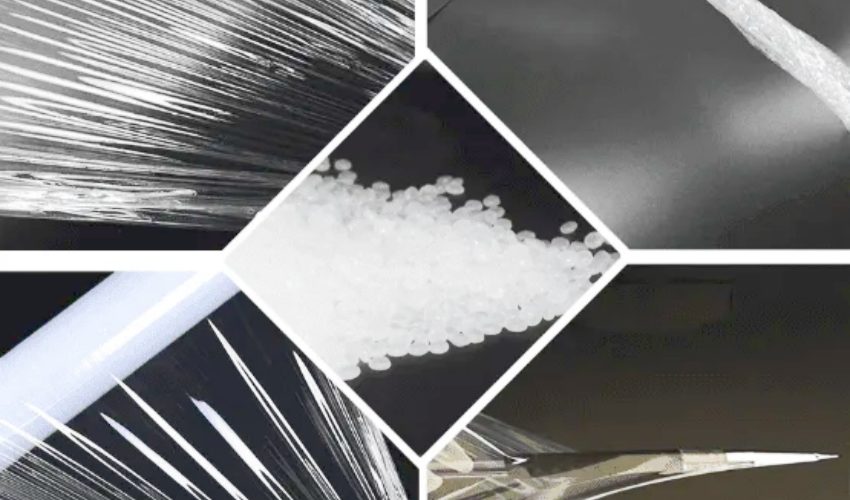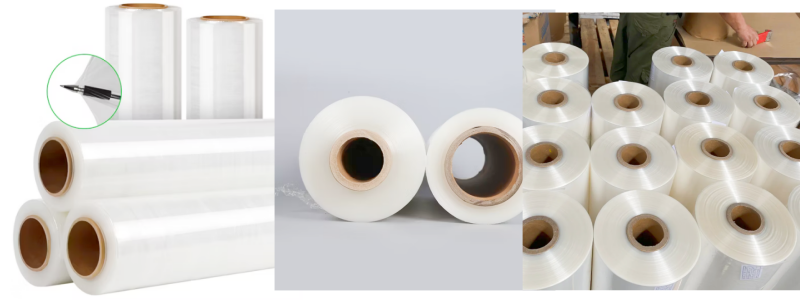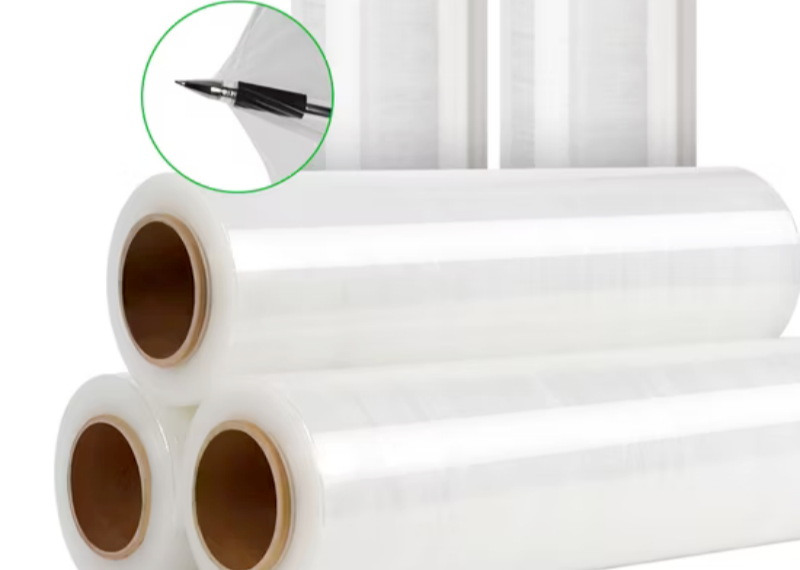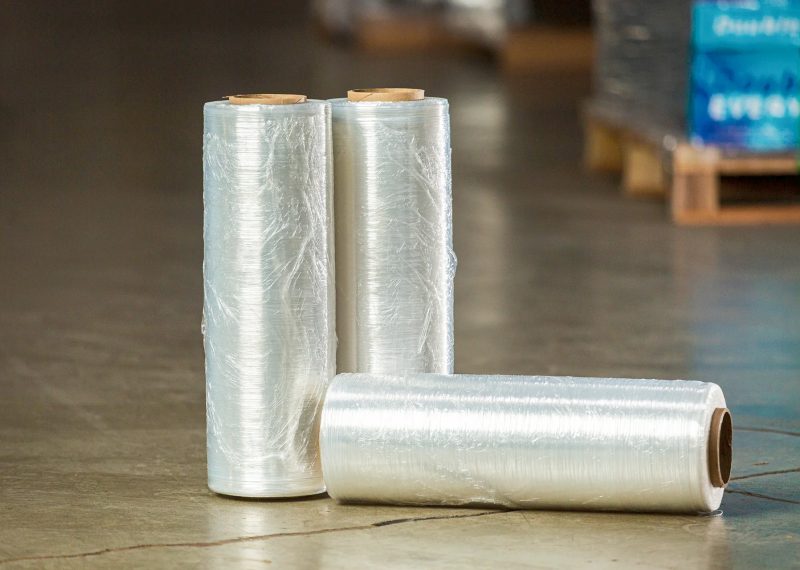
Stretch film, a highly stretchable plastic film, is commonly used to bind, secure, and protect items during packaging, storage, and transport. Made from carefully selected materials, it offers significant benefits in terms of load stability, protection against dust and moisture, and ease of handling for palletized goods. The raw material stretch film is especially valuable in logistics and warehousing as it helps ensure that products remain intact and well-protected, even in challenging conditions. Patented stretch film, developed through innovative techniques, further enhances these benefits by offering superior tensile strength and improved stretchability. Its performance is relatively strong, with tensile resistance primarily used in pallet wrapping and storage operations. This post will delve into the essential raw materials used to create stretch film, shedding light on how these materials, including patented innovations, contribute to its durability, flexibility, and overall performance in various industrial applications. Understanding these raw materials is key to selecting the right film for your specific packaging needs.
Why Choose Our Stretch Film Over Competitors?

| Attribute | Description |
|---|---|
| Type | Raw Material Stretch Film |
| Brand Name | PWP Stretch Film |
| Place of Origin | Fujian, China |
| Material | LLDPE (Linear Low-Density Polyethylene), PE |
| Thickness | 5 mic - 20 mic, Customizable |
| Length | 100m - 500m, Customizable |
| Stretch Rate | ≥400% |
| Features | Water-Soluble, Moisture-Proof, Anti-Static, Waterproof, Dustproof, Eco-Friendly, Sustainable, Durable, High Stretchability, Industrial Grade |
| Hardness | Soft |
| Transparency | Transparent |
| Industrial Use | Chemical, Beverage, Textiles, Packaging Heavy-Duty Items |
| Customization | Custom Logo Printing, Intaglio Printing, Width, Length, and Color Options |
| Processing Type | Multiple Extrusion, 5-Layer Extrusion |
| MOQ | 1 Roll (for regular orders), 1000kg (bulk orders) |
| Application | Hand Roll, Machine Roll, Pallet Wrapping, Packaging Film |
| Usage | Packaging fragile, heavy-duty, or sensitive items |
| Certificate | ISO, MSDS |
| Warranty | 2 Year |
| Packaging Details | Packed in cartons and placed on pallets for bulk shipment |
In producing raw material stretch film, selecting the right materials is essential for achieving the desired balance of flexibility, strength, and performance. The choice of materials impacts the stretch film’s ability to withstand forces during wrapping, transportation, and storage, ensuring that items remain secure and protected. For instance, wrapping film is designed to provide a reliable barrier against external elements while offering stretchability and durability. By choosing the correct formulation for the wrapping film, manufacturers can optimize its performance, ensuring that goods are safely wrapped and easily handled during all stages of the supply chain.
The primary raw material in stretch film production is Linear Low-Density Polyethylene (LLDPE). Known for its excellent stretchability, impact resistance, and flexibility, LLDPE provides the backbone of raw material stretch film. Its unique molecular structure allows for greater elongation, making it ideal for applications that require a film to stretch over various loads without tearing. Additionally, LLDPE contributes to the film’s resilience, enabling it to handle the demands of load stabilization effectively. Shavings of stretch film, often generated during the manufacturing or application process, can be recycled and reprocessed into new film, further enhancing the sustainability of LLDPE-based stretch film production.
To further enhance raw material stretch film, manufacturers incorporate several additional polymers and resins.
Together, these materials ensure that raw material stretch film offers high-quality performance, versatility, and reliability across a range of packaging and industrial uses.

The process of selecting the appropriate raw material stretch film involves several key steps to ensure optimal performance, cost-efficiency, and suitability for specific applications. Below is a detailed outline of the selection method:
Before choosing a stretch film, clearly outline the needs of the application. Key factors to consider include:
The stretch film’s physical and mechanical properties are crucial for effective performance:
Different types of raw materials are used in stretch film production, and each has specific advantages:
The method of application impacts the choice of stretch film:
Balance the material’s cost against its performance and durability. Consider the following:
Before finalizing the selection, perform real-world tests to verify the film’s performance:
Many businesses are adopting eco-friendly practices:
Selecting the right raw material stretch film is a meticulous process that combines an understanding of application requirements, film properties, and environmental considerations. Regular evaluations and improvements based on feedback and evolving technologies can ensure continued efficiency and sustainability in packaging operations.
Additives play a crucial role in enhancing the performance, durability, and functionality of stretch films. These additives are blended with the base polymer (typically Linear Low-Density Polyethylene or LLDPE) during the manufacturing process to impart specific properties tailored to different applications. Below is an overview of the common additives used in raw material stretch films:
The use of additives in raw material stretch films significantly enhances their functionality, catering to diverse industrial requirements. Selecting the right combination of additives depends on the intended application, environmental conditions, and cost considerations. Understanding these additives allows manufacturers to produce tailored solutions that meet specific packaging needs efficiently and effectively.

The properties of raw material stretch film are carefully engineered to meet the demands of various packaging applications. From its stretching capabilities to its resistance against environmental factors, these properties determine how well the film performs in securing and protecting items. Each material used in stretch film brings unique qualities, ensuring that the film can be tailored to specific uses, such as long-term storage, heavy load stability, or outdoor protection.
One of the most critical performance metrics for raw material stretch film is its ability to stretch at break. This refers to the film’s capacity to elongate under stress without tearing, which directly impacts how well it secures loads. Higher stretch percentages allow the film to wrap tightly around objects, providing robust support without breaking. Additionally, this stretch capability is paired with elastic recovery, meaning that after being stretched, the film tries to return to its original shape. This characteristic helps ensure that loads remain tightly bound even if they shift slightly during transit, offering continuous support and minimizing the risk of load displacement.
The cling property of raw material stretch film is essential for maintaining load stability. Cling allows the film layers to stick to each other, helping keep wrapped items intact during movement. Good cling is especially valuable in pallet wrapping, as it prevents layers from unwinding or loosening, which could compromise the load’s security.
In addition to cling, material strength is a critical component of stretch film performance. A strong film resists tearing and punctures, making it ideal for packaging products with sharp edges or irregular shapes. The high tensile strength of stretch film can endure the rigors of handling and transportation, offering dependable protection and minimizing film waste due to breakage.
For applications where raw material stretch film may be exposed to sunlight or other environmental factors, UV protection is an essential feature. UV stabilizers are often added to the film to shield it from the harmful effects of ultraviolet radiation, which can cause the material to degrade over time. This additive is especially important for outdoor storage or transport, as it helps maintain the film’s integrity and protective qualities under prolonged sun exposure.
Other additives, such as anti-static agents, can be incorporated into the raw material stretch film to address specific environmental conditions or packaging needs. By tailoring the film with these properties, manufacturers create versatile and durable stretch films suitable for various industries and climates, ensuring that the packaging remains effective and protective across diverse scenarios.

The manufacturing processes of raw material stretch film play a crucial role in determining its final characteristics, such as clarity, thickness, and puncture resistance. Two primary processes are used: the blown film process and the cast film process. Each method has unique advantages and limitations, which influence the type of applications for which the stretch film is best suited.
In the blown film process, the raw material, typically polyethylene resin, is heated until molten and then forced through a circular die to form a tube. This tube is then blown with air, creating a large bubble of stretched film that is gradually cooled and flattened. After cooling, the film is cut into sheets or rolled onto spools for distribution.
The blown film process is valued for producing stretch film that is tough, with a slightly hazy appearance and high puncture resistance. These films are especially effective in applications requiring durability and resilience, such as wrapping irregularly shaped or heavy items. The toughness of blown raw material stretch film makes it ideal for use in demanding industrial settings. Stretch film producers often rely on this process to create high-quality films that meet the performance requirements of various industries, ensuring products are securely wrapped and protected during transportation and storage.
Pros of the Blown Film Process:
Cons of the Blown Film Process:
The cast film process differs from blown stretch film production in that the molten resin is extruded through a narrow slot (die) onto a large, cooled drum. This rapid cooling of the film produces a stretch film with exceptional clarity and a consistent thickness. Cast films are then wound onto rolls and prepared for use in both manual and machine wrapping.
Cast raw material stretch film is known for its high clarity, making it ideal for packaging applications where visibility is important. This film unwinds quietly, which can improve the work environment in warehouses or other settings where film is used extensively. However, it does not possess the same level of puncture resistance as blown film, so it may be less suitable for heavy-duty or sharp-edged loads.
Pros of the Cast Film Process:
Cons of the Cast Film Process:
Each method of producing raw material stretch film provides unique benefits, allowing manufacturers to offer a range of products tailored to different packaging requirements. Whether toughness or clarity is prioritized, understanding these processes can guide the selection of stretch films best suited for specific applications.
In packaging and logistics, selecting the appropriate type of raw material stretch film is essential for efficiency, cost-effectiveness, and load stability. There are two primary categories: hand stretch film and machine stretch film. Each type offers distinct advantages suited to specific applications, depending on the volume, load consistency, and level of automation needed.
Hand stretch film is designed for manual application, making it ideal for small to medium-sized operations or situations where packaging needs vary. This type of raw material stretch film is commonly used in warehouses, small businesses, or environments that require portability and flexibility. Hand stretch film is straightforward to apply without the need for specialized equipment, making it accessible for businesses with lower volume needs or budget constraints.
Advantages of Hand Stretch Film:
Disadvantages of Hand Stretch Film:
Machine stretch film is intended for use with stretch wrapping machines, making it the preferred choice for high-volume applications or settings where consistent application is critical. By using automated equipment, machine-applied raw material stretch film can wrap pallets more efficiently and with uniform tension, ensuring the load is secure and stable throughout transportation.
Advantages of Machine Stretch Film:
Types of Machine Stretch Film:
Both hand and machine stretch films play a vital role in packaging, each offering unique benefits tailored to different operational needs. Whether opting for the flexibility of hand stretch film or the efficiency of machine stretch film, understanding the types and applications of raw material stretch film enables businesses to choose the best solution for their logistics and packaging requirements.
For applications where durability and resilience are essential, selecting a good toughness raw material stretch film is vital. Toughness is a key performance property, particularly in industrial and heavy-duty packaging. A tough stretch film ensures that loads are securely wrapped, stable during transportation, and protected from external stresses like tears or punctures. The selection of specific raw materials directly influences the film’s toughness, with certain materials enhancing strength, flexibility, and impact resistance.
In industrial and heavy-duty environments, stretch film must withstand demanding conditions such as handling, stacking, and shipping. High toughness in raw material stretch film provides additional security, especially for large or heavy loads that require extra protection against tearing and puncturing. Without this toughness, the film might fail under stress, leading to potential load instability, product damage, or inefficiency in the transportation process. Thus, toughness is essential for ensuring safety, minimizing material waste, and maintaining effective load containment.
Several raw materials are commonly chosen to enhance the toughness of stretch films. Each material provides unique qualities that contribute to the film’s overall resilience:
Good toughness raw material stretch film factories is widely used in industries that involve heavy-duty packaging and logistics. It is essential for applications where load integrity and film durability are critical:
With these materials and applications in mind, a good toughness raw material stretch film can significantly improve load security and performance in high-demand settings.
Selecting the right raw material for stretch film manufacturer is essential for businesses that rely on durable, high-performance packaging solutions. These manufacturers play a critical role in creating reliable stretch films by focusing on raw material quality and performance. Leading companies in the stretch film industry produce films that meet the demands of various applications, from heavy-duty industrial wrapping to everyday packaging, by ensuring they use top-grade materials like LLDPE and specialized resins.
Top manufacturers in the raw material stretch film industry are known for their innovation and commitment to quality. They often specialize in developing advanced materials such as Linear Low-Density Polyethylene (LLDPE) and metallocene resins, which enhance the film’s strength, stretchability, and durability. By investing in high-grade raw materials, these companies ensure that their stretch films can withstand demanding conditions without compromising load stability or protective qualities. Well-established raw material stretch film suppliers manufacturers maintain rigorous standards for production and testing, often providing custom solutions to meet specific industry requirements.
Selecting the right raw material stretch film manufacturer requires careful consideration of a few key criteria:
A reliable raw material stretch film manufacturer will offer a product that not only meets but exceeds performance standards, supporting efficient and effective packaging operations across various industries.
Raw material stretch film is widely used across industries due to its versatility, protective qualities, and cost-effectiveness. Below are its common applications:
Raw material stretch film is an indispensable tool across a variety of sectors due to its adaptability, protective features, and cost-efficiency. Its broad applications demonstrate its importance in modern packaging, storage, and transportation processes.
Stretch film is primarily made from a type of plastic known as polyethylene. The specific type of polyethylene most commonly used is Linear Low-Density Polyethylene (LLDPE), which provides stretch film with its signature flexibility, stretchability, and puncture resistance. This material allows the film to tightly wrap around and secure various items, protecting them during shipping, storage, and handling. LLDPE’s structure makes it ideal for creating a thin, durable film that can stretch without breaking, while offering a tight cling that keeps loads stable and intact. Other forms of polyethylene, such as Low-Density Polyethylene (LDPE) and Polypropylene (PP), may also be added to enhance specific qualities like clarity, strength, or heat resistance.
The primary ingredient in stretch film is Linear Low-Density Polyethylene (LLDPE), which gives the film its flexibility and strength. Additional ingredients are often incorporated to optimize the film’s performance based on specific applications. For example, polypropylene (PP) can be added to improve heat resistance and stiffness, while Ethylene Vinyl Acetate (EVA) enhances stretchability and strength. Other additives may include UV stabilizers for films used outdoors, where exposure to sunlight can degrade the material over time. These ingredients work together to create a film that balances strength, flexibility, and durability, making it suitable for securely wrapping and stabilizing various load types during transport and storage.
Stretch film is composed mainly of Linear Low-Density Polyethylene (LLDPE), the essential component that ensures high stretchability and resistance to punctures. To achieve desired properties, manufacturers also blend in additional materials like Low-Density Polyethylene (LDPE), which provides added flexibility, and Metallocene, which enhances strength and clarity for improved film quality. Polypropylene (PP) is sometimes incorporated to increase the film’s resistance to heat and add stiffness, while Ethylene Vinyl Acetate (EVA) is used to boost overall elasticity and tensile strength. These components are carefully selected and balanced to create a film with the ideal characteristics for wrapping, securing, and protecting goods in various environments.
The primary raw material used in the production of stretch film is Linear Low-Density Polyethylene (LLDPE), a highly flexible and durable polymer. LLDPE is the backbone of stretch film due to its excellent tensile strength, allowing the film to be stretched and wrapped tightly around loads without tearing. Other raw materials that may be added to LLDPE include Low-Density Polyethylene (LDPE) for increased pliability, Polypropylene (PP) for added rigidity and heat resistance, and Metallocene additives to enhance clarity and strength. These raw materials contribute to the unique properties of stretch film, making it resilient, transparent, and versatile for use across many packaging and shipping applications.
Cast stretch film is made using polyethylene (PE), specifically linear low-density polyethylene (LLDPE). During manufacturing, molten PE resin is extruded through a flat die onto a cooling roller, which rapidly solidifies the material. This process gives cast stretch film its excellent clarity, high stretchability, and smooth surface, making it ideal for packaging applications. Additives may be incorporated to enhance properties like UV resistance or tackiness.
The primary raw material for stretch film is linear low-density polyethylene (LLDPE). It is often combined with additives to improve elasticity, durability, and cling properties. These additives can include plasticizers, UV stabilizers, or slip agents. In some cases, other polyethylene variants, like low-density polyethylene (LDPE) or high-density polyethylene (HDPE), are blended with LLDPE to tailor the film’s performance for specific applications.
Linear low-density polyethylene (LLDPE) is considered the best material for stretch films due to its superior stretchability, puncture resistance, and cling properties. LLDPE offers an ideal balance between flexibility and strength, making it suitable for wrapping pallets and securing loads. Depending on the application, films with specific formulations may include additional layers or additives to improve performance.
Cling film and stretch film are both made from polyethylene but serve different purposes. Cling film is thinner and used for wrapping food items to preserve freshness. It has a sticky surface that adheres well to itself. Stretch film, on the other hand, is thicker, more elastic, and designed for industrial applications, such as securing pallets. Stretch film emphasizes load stability and strength, whereas cling film focuses on food safety and convenience.
Stretchy materials are typically made of polymers like elastomers, including natural rubber, synthetic rubbers, or thermoplastic elastomers. For stretch films, the key ingredient is linear low-density polyethylene (LLDPE), a polymer known for its flexibility and elongation properties. In textiles, spandex (lycra) or elastic blends are common for creating stretchable fabrics.
Polyethylene (PE) is a thermoplastic polymer made from the polymerization of ethylene. It is highly versatile and comes in various densities, such as high-density polyethylene (HDPE), low-density polyethylene (LDPE), and linear low-density polyethylene (LLDPE). PE is widely used in packaging, containers, films, and piping due to its durability, chemical resistance, and lightweight properties. It is recyclable and commonly found in consumer and industrial applications.

My name is James Thompson, and I’m the editor of this website dedicated to Stretch Film, Pallet Wrap, and Stretch Wrap products.
My passion for packaging began when I noticed the challenges companies face in securing their products efficiently for transportation and storage. This inspired me to delve deep into the world of stretch films and pallet wraps, exploring the latest technologies and best practices.
I aim to provide valuable insights, practical tips, and up-to-date industry trends to assist you in making informed decisions. Whether you’re a small business owner or part of a large corporation, my goal is to support you in optimizing your operations and ensuring your products reach their destination safely.
Thank you for visiting, and I look forward to accompanying you on your journey toward better packaging solutions.
Comments are closed